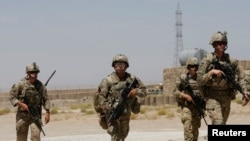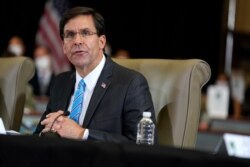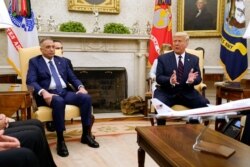The U.S. military is drawing down to 3,000 troops in Iraq this month and 4,500 in Afghanistan by November, the head of U.S. Central Command said Wednesday.
“We’re on a glide slope (in Afghanistan) to be at 4,500 by the November time frame, late October, November time frame,” Marine Gen. Kenneth “Frank” McKenzie said in an interview with VOA and two other media outlets.
“At 4,500 we’re still going to be able to accomplish the core task that we want to accomplish, and we’ve shown more than ample goodwill in our willingness to demonstrate that we don't want to be an occupying force in this country, but we do have strategic interests, vital interests, that compel us to be certain that these entities such as al-Qaida and ISIS can’t be guests there to attack the United States,” McKenzie added.
In July, the CENTCOM commander told VOA that inter-Afghan dialogue would need to begin and the U.S. would need to be confident that the Taliban would not host Islamic State and al-Qaida terrorist groups before U.S. troops could be greatly reduced in Afghanistan.
When asked what has changed, McKenzie on Wednesday acknowledged the Taliban “has still not shown conclusively that they are going to break with al-Qaida” and have “continued to go after the Afghan security forces.”
Afghanistan’s warring factions were expected this week to begin their first direct peace talks in Qatar amid U.S.-led international calls for them to seize the “historic opportunity” to end the country’s long war.
Top leaders have discussed upcoming troop withdrawals from Afghanistan and Iraq in recent weeks, but the general's announcements provide the clearest details to date. Defense Secretary Mark Esper told Fox News last month that the U.S. planned to go down to fewer than 5,000 troops in Afghanistan by the end of November.
Earlier on Wednesday, McKenzie announced during a visit to Iraq that the U.S. troop presence in the country would be cut from 5,200 to 3,000.
McKenzie later told reporters the reduced footprint in Iraq would not affect the U.S. ability to protect its remaining troops.
“Nothing we're pulling out is going to affect our ability to defend ourselves. And I won't go into the tactical details, but it will not affect Patriot (missile defense) capability, or any other short-range defense capability in any of our bases. All of those will remain,” the CENTCOM chief said.
Attacks from Iranian-backed proxy forces have continued in recent weeks, McKenzie added, but “none of them have caused any U.S. casualties and no significant Iraqi casualties.”
He said the remaining forces would continue advising and assisting Iraqi partners in “rooting out the final remnants” of the Islamic State terror group in Iraq and “ensuring its enduring defeat.”
“This decision is due to our confidence in the Iraqi security forces’ increased ability to operate independently,” McKenzie said during his remarks in Iraq.
Bradley Bowman, a defense expert with the Washington-based think tank Foundation for Defense of Democracies, raised concerns Wednesday that the two announcements could be due to “a calendar or political motivation with respect to the (U.S. presidential) election.”
“This announcement appears to be larger and faster than anticipated,” Bowman said. “This does smack a little bit of a calendar-based withdrawal that we've seen time and again is a mistake, but I am pleased that it is not a complete withdrawal.”
The U.S. presidential election is on November 3.
U.S. President Donald Trump frequently talks about wanting to end what he calls the country’s “endless wars.”
“We have been taking our troops out of Iraq fairly rapidly, and we look forward to the day when we don’t have to be there,” Trump said last month as he hosted Iraqi Prime Minister Mustafa al-Kadhimi at the White House. “And hopefully Iraq can live their own lives and they can defend themselves, which they’ve been doing long before we got involved."
Trump also told Fox News last month that the U.S. was bringing its troops home from Iraq and Syria.
But McKenzie said he has not received orders to withdraw to fewer than 3,000 forces in Iraq, and the U.S. military is not currently planning to remove the more than 700 forces it has in Syria.
“I've been given no instructions to get out of Syria. I think in the long term, you know, we're going to go down in Syria. I think that that's clear and inevitable, and we're prepared to do that, when so directed,” he said Wednesday.
U.S. troops in Syria are supporting the Syrian Democratic Forces fighting the last remnants of Islamic State east of the Euphrates River and helping them prevent terrorists from recapturing oil fields.








